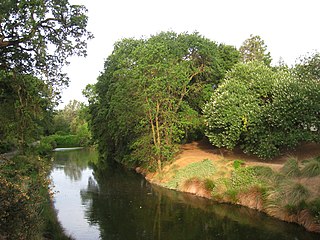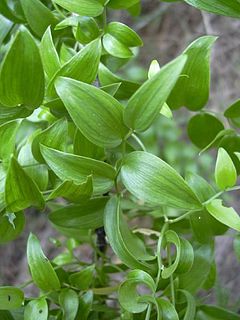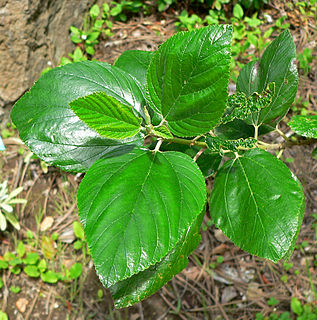
Chaparral is a shrubland or heathland plant community found primarily in the US state of California and in the northern portion of the Baja California Peninsula, Mexico. It is shaped by a Mediterranean climate and wildfire, featuring summer-drought-tolerant plants with hard sclerophyllous evergreen leaves, as contrasted with the associated soft-leaved, drought-deciduous, scrub community of coastal sage scrub, found below the chaparral biome. Chaparral covers 5% of the state of California and associated Mediterranean shrubland an additional 3.5%. The name comes from the Spanish word chaparro, for evergreen oak shrubland.

Sorghum is a genus of flowering plants in the grass family Poaceae. Seventeen of the 25 species are native to Australia, with the range of some extending to Africa, Asia, Mesoamerica, and certain islands in the Indian and Pacific Oceans. One species is grown for grain, while many others are used as fodder plants, either cultivated in warm climates worldwide or naturalized, in pasture lands. Sorghum is in the subfamily Panicoideae and the tribe Andropogoneae.

A shrub or bush is a small- to medium-sized perennial woody plant. Unlike herbaceous plants, shrubs have persistent woody stems above the ground. They are distinguished from trees by their multiple stems and shorter height, less than 6 m-10 m (20 ft–33 ft) tall. Small shrubs, less than 2 m (6.6 ft) tall are sometimes termed subshrubs.

Ceanothus L. is a genus of about 50–60 species of nitrogen-fixing shrubs or small trees in the family Rhamnaceae. Common names for members of this genus are California lilac, wild lilac, and soap bush. "Ceonothus" comes from a Greek word meaning "spiny plant", Ancient Greek: κεάνωθος (keanōthos), which was applied by Theophrastus to an Old World plant believed to be Cirsium arvense.

The University of California, Davis Arboretum is an approximately 100-acre (0.40 km2) arboretum along the banks of the old north channel of Putah Creek on the south side of the University of California, Davis campus in unincorporated Yolo County, California, in the United States.

The Arboretum at the University of California, Santa Cruz, also called the UCSC Arboretum, is an arboretum located on the campus of the University of California, Santa Cruz, in Santa Cruz, California in the United States.

The University of California Botanical Garden is a 34-acre botanical garden located on the University of California, Berkeley campus, in Strawberry Canyon. The Garden is in the Berkeley Hills, inside the city boundary of Oakland, with views overlooking the San Francisco Bay. It is one of the most diverse plant collections in the United States, and famous for its large number of rare and endangered species.

Asparagus asparagoides, commonly known as bridal creeper, bridal-veil creeper, gnarboola, smilax or smilax asparagus, is a herbaceous climbing plant of the family Asparagaceae native to eastern and southern Africa. Sometimes grown as an ornamental plant, it has become a serious environmental weed in Australia and New Zealand.

Carissa spinarum, the conkerberry or bush plum, is a large shrub of the dogbane family (Apocynaceae), widely distributed in tropical regions of Africa, Southern Asia, Australia, and various islands of the Indian Ocean. It is most well known in Australia, where it is also called currant bush or, more ambiguously, native currant or even black currant. It is, however, neither closely related to plums (Prunus) nor to true currants (Ribes), which belong to entirely different lineages of eudicots. In India, it is also called wild karanda /wild karavanda, referring to the related karanda. Carissa spinarum is often discussed under its many obsolete synonyms.
Burning bush is described in the Book of Exodus and used as a symbol of various Presbyterian denominations.

Ceanothus arboreus, with the common names feltleaf ceanothus, island ceanothus, and island mountain lilac, is a species of Ceanothus shrub in California.

Ceanothus cuneatus is a species of flowering shrub known by the common names buckbrush and wedgeleaf ceanothus.

The South Sierra Wilderness is a federally designated wilderness area in the Southern Sierra Nevada, in eastern California. It is located 65 miles (105 km) northeast of Bakersfield, and is southwest of Owens Lake and Olancha.

Blueberries are perennial flowering plants with blue– or purple–colored berries. They are classified in the section Cyanococcus within the genus Vaccinium.Vaccinium also includes cranberries, bilberries, huckleberries and Madeira blueberries. Commercial "blueberries" – including both wild ('lowbush') and cultivated ('highbush') blueberries – are all native to North America. The highbush blueberry varieties were introduced into Europe during the 1930s.

Guaiacum angustifolium is a species of flowering plant in the caltrop family, Zygophyllaceae. Common names include Texas guaiacum, Texas lignum-vitae, soapbush and huayacán. It is native to southern and western Texas in the United States and northern Mexico. The specific name is derived from the Latin words angustus, meaning "narrow," and folius, meaning "leaf."

Ceanothus gloriosus is a species of shrub in the buckthorn family Rhamnaceae known by the common name Point Reyes ceanothus. It is endemic to California, where it is known from the coastline of the San Francisco Bay Area and areas north and south. It grows on seaside bluffs and the slopes of the coastal mountains. This shrub grows flat and spreading to erect, approaching two meters in maximum size. The evergreen leaves are oppositely arranged and up to 5 centimeters long, rounded to oval in shape. The edges are toothed, the teeth sometimes spine-tipped. The inflorescence is a small cluster of bright blue to purple flowers. The fruit is a horned capsule about 4 millimeters wide.

Ceanothus velutinus, with the common names snowbrush ceanothus, red root, and tobacco brush, is a species of shrub in the family Rhamnaceae. It is native to western North America from British Columbia to California to Colorado, where it grows in several habitat types including coniferous forest, chaparral, and various types of woodland.

Ceanothus herbaceus, also known as Jersey tea, is a species of shrub in the buckthorn family, Rhamnaceae and is similar to C. americanus and C. sanguineus. It is a perennial shrub which is native to North America.

Cassytha filiformis, common name love-vine, is a species of obligate parasitic vine in the family Lauraceae. The species has a native pantropical distribution encompassing the Americas, Indomalaya, Australasia, Polynesia and tropical Africa In the Caribbean region, it is one of several plants known as "Love vine" because it has a reputation as an aphrodisiac.





















